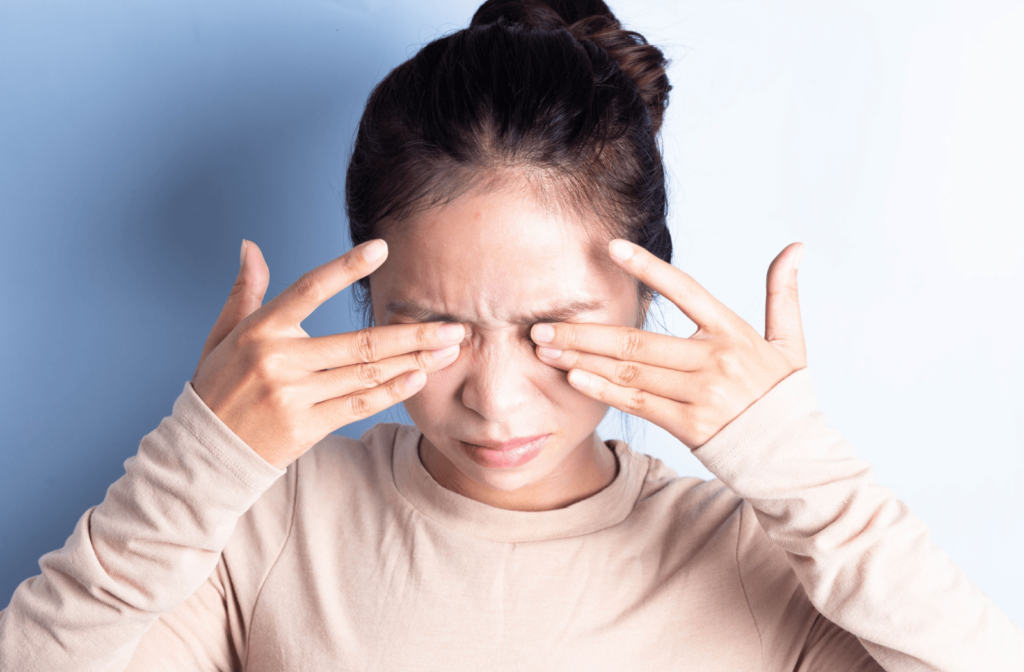We know caring for our physical health is important, but we may need to be reminded to take care of our eyes. Some take it for granted when their eyes are healthy and working correctly. But we rely so much on our vision to get us through our daily lives, so it’s important to maintain good eye health.
One common issue affecting many people is dry eyes, which can cause discomfort and even blurriness. For millions of Canadians, dry eyes are a daily struggle, and understanding how it can affect your vision is a vital step to protecting your eye health.
What Is Dry Eye Disease?
Dry eye disease is a common condition that many people experience at some point in their lives. Dry eyes are categorized as:
- Evaporative dry eyes: your tears are low-quality and evaporate too fast.
- Aqueous deficiency dry eyes: your body doesn’t produce enough tears to adequately hydrate your eyes.
While evaporative dry eye is most common (responsible for 9 out of 10 cases, to be exact), both conditions affect your tear film. This film is the thin layer of tears that coats your eyes, keeping your eyes hydrated, protected, and comfortable.
Some common risk factors for dry eyes include:
- Age: dry eyes most commonly affect those over 65.
- Sex: dry eye disease disproportionately affects women.
- Medications: antihistamines, decongestants, and antidepressants produce ocular symptoms.
- Environment: Hot, dry, or windy environments cause the tear film to evaporate too quickly.
- Autoimmune conditions: Sjögren’s syndrome and rheumatoid arthritis can impact the eyes.
- Inflammatory skin/eyelid disorders: inflammation can lead to dry eyes.
- Not blinking: using a digital screen for a long time causes you to blink less often, drying out your tear film.
Dry Eye Symptoms
We’ve already mentioned dry eyes can cause blurriness, but you may also experience other symptoms, such as:
- Redness
- Stinging, scratchiness, or a gritty feeling
- Light sensitivity
- Stringy mucus
- Difficulty wearing contact lenses
- Watery eyes
Chronic dry eyes can leave the front of the eye (the cornea) unprotected. Usually, your tear film washes away dust or dirt that lands on the cornea. However, with dry eyes, these particles could eventually cause damage or scarring.
Why Do Dry Eyes Cause Blurriness?
Dry eyes aren’t always the direct cause of blurry vision. In fact, sometimes dry eyes and blurriness are both symptoms of a different condition that’s affecting your vision. If you treat your dry eyes but the blurriness remains, it could be a sign of something more serious, and you should inform your optometrist.
Watery Eyes
Some people notice that their eyes are excessively watery and uncomfortably gritty. It’s a natural reaction of your body trying to produce extra moisture to provide you with some relief.
Typically, your body detects eye irritation and tells the glands to start making tears to wash it away. If you have evaporative dry eye disease, these tears will likely evaporate before they can make a difference. In turn, your body will produce even more tears, and the cycle begins again.
All these extra tears can affect your vision, kind of like looking through a glass of water.

Digital Eye Strain
Digital eye strain, or computer vision syndrome, is a common condition resulting from the extended use of digital screens.
People tend to blink less when looking at screens: only 4 times per minute compared to the average of 17 times per minute. Lack of blinking causes your tear film to evaporate, leading to dry eyes and blurry vision.
A good rule of thumb is to take regular breaks using the 20-20-20 rule: every 20 minutes, look at something at least 20 feet away for 20 seconds.
Contact Lenses
Contact lenses are a preferred vision correction method for many. However, your optometrist must fit them to your eyes for them to be comfortable and work correctly. If you have dry eyes, contact lens use can lead to blurry vision.
Contact lenses can also worsen your dry eye symptoms. Soft contacts need moisture to stay flexible, and they may absorb moisture from your eyes if worn for longer than their intended schedule.
Protecting Your Vision from Dry Eyes
Dry eyes can be frustrating and negatively impact your daily life. The good news is that optometrists offer effective treatments to help you manage this condition and relieve uncomfortable symptoms.
Depending on the cause, your optometrist might suggest:
- Artificial tears: One of the simplest methods of relief is simply adding more moisture to the eyes. Artificial tears are eye drops that lubricate the eyes and provide temporary hydration. They come in many different types, so always talk with your eye doctor before using them.
- Heat masks: Blockages in the meibomian glands cause most dry eyes. Without the meibum oil secreted by these glands, your tears may evaporate too fast. Heat masks can break down these blockages.
- Prescription eye drops: Medications for dry eyes are designed to reduce inflammation and promote tear production.
- IPL & RF treatment: Along the same lines as heat masks, intense pulsed light (IPL) and radio frequency (RF) treatments address meibomian gland dysfunction. They heat your eyelids and liquify oil blockages using light or heat and gentle massages.
A Solution for Dry Eyes in Maple Ridge
Dry eye disease can cause discomfort and blurred vision, impacting your daily life. But it doesn’t have to.
Maple Ridge Eye Care offers several dry eye therapy options. We’ve helped many of our patients find effective ways to manage their symptoms and find relief. If dry eyes are taking over your life, book an appointment with our expert team and discover how comfortable eyes are within your grasp.


